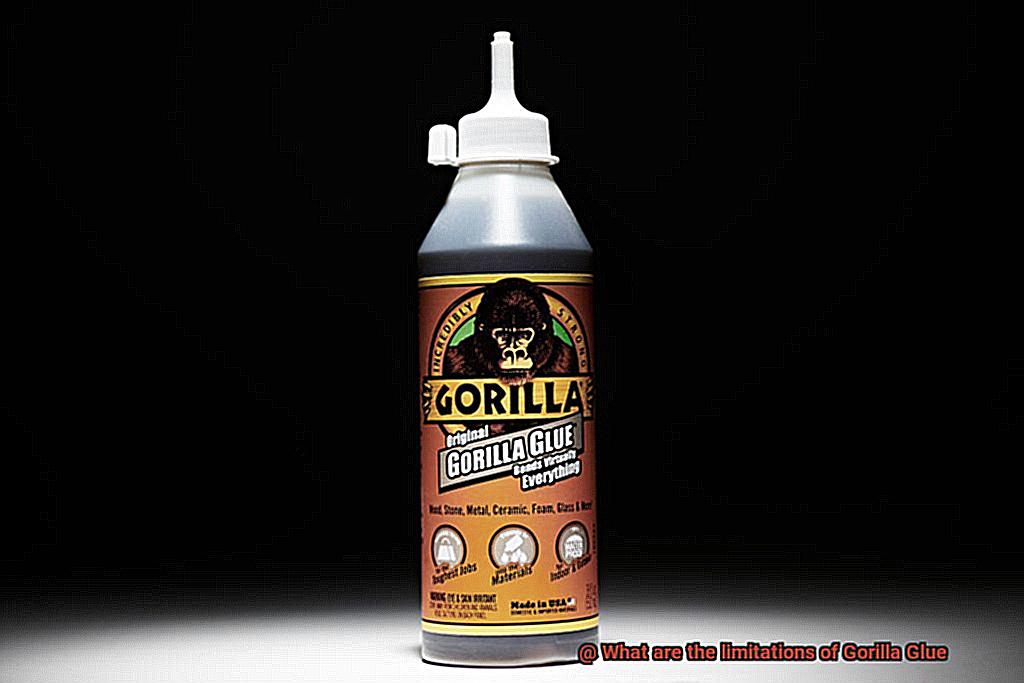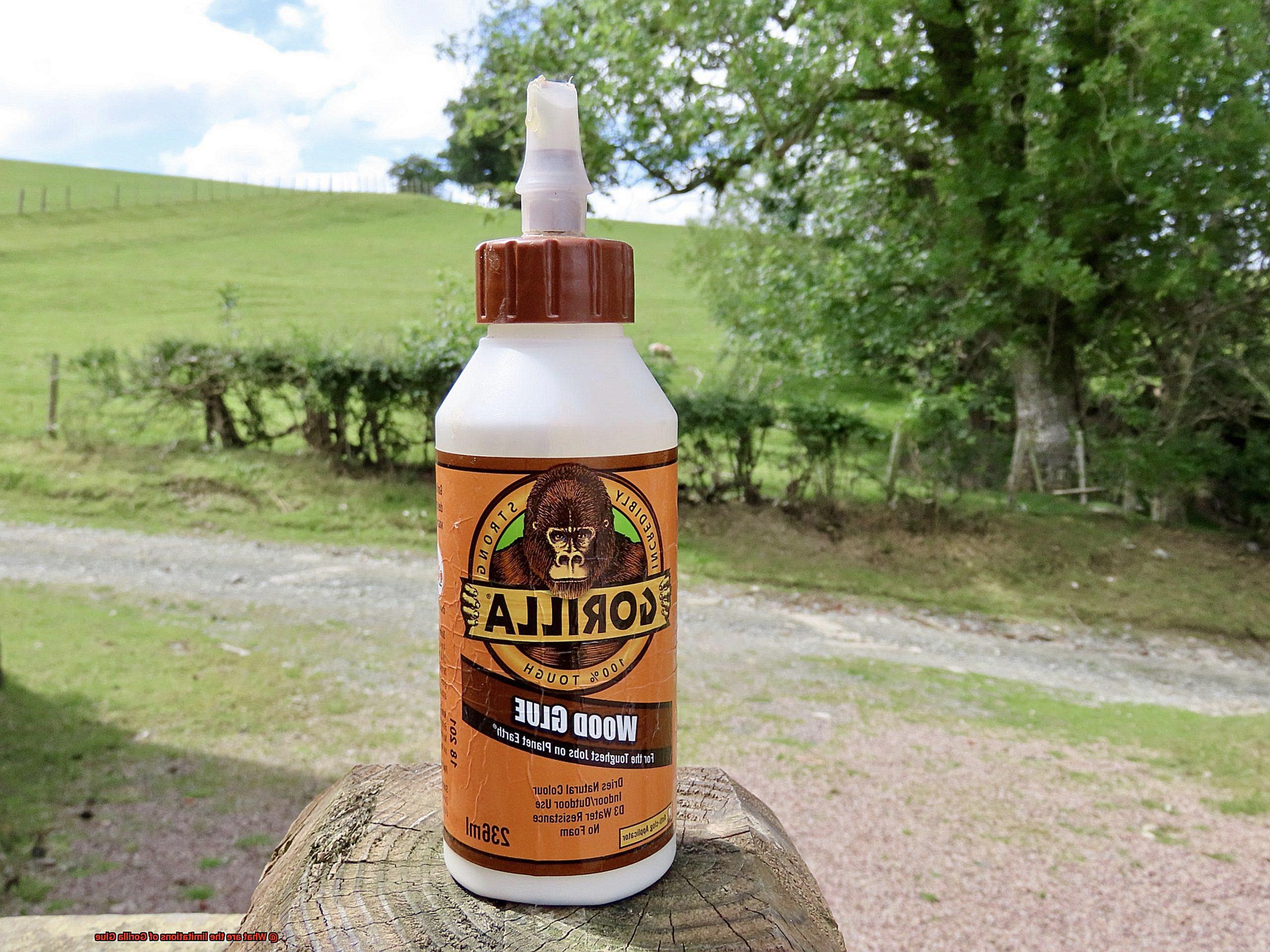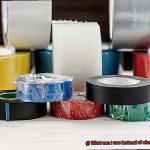Welcome to our blog post on the limitations of Gorilla Glue.
This super-strong adhesive has become a go-to for many DIY enthusiasts and fix-it wizards. But, like any superhero, even Gorilla Glue has its kryptonite.
In this post, we’ll dive into the world of this mighty adhesive and uncover its limitations. So buckle up, because we’re about to reveal the hidden truths and lesser-known aspects of Gorilla Glue that you need to know before you embark on your next project.
Get ready to discover when Gorilla Glue might not be your best bet.
Curing Time
Contents
- 1 Curing Time
- 2 Bonding Limitations
- 2.1 Limitation 1: Incompatibility with Certain Plastics
- 2.2 Limitation 2: Sensitivity to Moisture
- 2.3 Limitation 3: Unsuitability for Continuous Immersion in Water
- 2.4 Limitation 4: Temperature Sensitivity
- 2.5 Limitation 5: Incompatibility with Flexible Materials
- 2.6 Limitation 6: Expansion during Curing
- 2.7 Limitation 7: Incompatibility with Foam and Fabrics
- 3 Sunlight and Temperature Issues
- 4 Expansion Problems
- 5 Difficult to Remove Once Cured
- 6 Odor Considerations
- 7 Tips for Successful Bonding with Gorilla Glue
- 8 Conclusion
When it comes to glue, efficiency and quick results are key. However, Gorilla Glue, renowned for its strength and versatility, presents a challenge with its long curing time. In this comprehensive guide, we will delve into the inconvenience of Gorilla Glue’s extended curing time and provide valuable tips on how to overcome this limitation.

The Frustration of Waiting:
Gorilla Glue’s curing time can extend up to 24 hours, depending on external factors such as temperature and humidity. This prolonged waiting period proves frustrating for users who require immediate results or need to complete their projects within a tight timeframe. Imagine having to put your project on hold for a whole day, unable to handle or manipulate the bonded items. It’s enough to test even the most patient among us.
Delicate Materials at Risk:
Working with delicate or fragile materials adds another layer of inconvenience when dealing with Gorilla Glue’s long curing time. The formidable adhesive properties of the glue exert significant pressure during the drying process, potentially damaging or distorting sensitive surfaces. Extra caution and care are required when using Gorilla Glue on delicate items.
Planning Ahead:
To counteract the inconvenience of Gorilla Glue’s lengthy curing time, meticulous planning is crucial. Take into account the necessary curing time when deciding to use this adhesive. Rushing the process or attempting to handle the bond prematurely may result in weak or incomplete adhesion, leading to disappointing results.
Exploring Alternatives:
If time is of the essence or you’re working with delicate materials, it may be wise to explore alternative adhesives with shorter curing times. The market offers various fast-drying glues that ensure quick bonding and reduced waiting periods. Researching and experimenting with different options can save you time and frustration in your future projects.
Optimizing Curing Conditions:
While Gorilla Glue may have a long curing time, you can expedite the process by optimizing the curing conditions. Proper ventilation, along with maintaining optimal temperature and humidity levels, can contribute to faster curing. By creating the ideal environment, you can significantly reduce the waiting time and get closer to achieving your desired results sooner.
Bonding Limitations
Gorilla Glue is a popular adhesive known for its strength and versatility in bonding various materials together. However, it is crucial to understand the limitations that come with using this adhesive to ensure successful bonding. In this article, we will dive into the various limitations of Gorilla Glue and provide insights into alternative adhesives that can overcome these challenges.
Limitation 1: Incompatibility with Certain Plastics
Gorilla Glue may struggle to bond certain plastics, such as polyethylene and polypropylene, due to their low surface energy. These plastics are chemically resistant to the adhesive, making it difficult to create a strong bond. To overcome this limitation, consider using specialized plastic adhesives or mechanical fasteners specifically designed for bonding such materials.
Limitation 2: Sensitivity to Moisture
While Gorilla Glue requires moisture for proper activation and curing, excessive moisture levels can negatively impact its performance. If the material being bonded is too wet or if there is high humidity in the environment, it can compromise the adhesive’s ability to form a strong bond. Ensure proper drying or consider using other moisture-resistant adhesives that can withstand these conditions.
Limitation 3: Unsuitability for Continuous Immersion in Water
Gorilla Glue is not recommended for surfaces that will be continuously immersed in water. While it can withstand occasional exposure, prolonged contact with water can weaken the bond over time. For water-related applications, consider using specialized waterproof adhesives that are specifically designed to maintain their strength even when submerged.
Limitation 4: Temperature Sensitivity
Extreme temperatures can alter Gorilla Glue’s properties, affecting its bonding strength. It is crucial to use Gorilla Glue within the specified temperature range for optimal results. In cases where extreme temperatures are involved, such as high-heat or low-temperature applications, consider using adhesives that are specifically formulated to withstand these conditions.
Limitation 5: Incompatibility with Flexible Materials
Gorilla Glue’s rigid nature makes it unsuitable for bonding flexible materials that undergo frequent movement or bending. Over time, the adhesive can become brittle and fail to withstand constant flexing. Look for flexible adhesives or those specifically designed for bonding flexible materials, which can provide the necessary strength and flexibility required for such applications.
Limitation 6: Expansion during Curing
Gorilla Glue expands as it cures, which can be advantageous in some applications but challenging in others. If precise alignment or a tight fit is required, the expansion of the glue can cause issues. Consider using low-expansion or non-expanding adhesives for such applications, which offer more control over the bonding process and minimize any potential complications.
Limitation 7: Incompatibility with Foam and Fabrics
Gorilla Glue is not intended for use on foam or fabrics, as its strong adhesive properties can damage or stain these materials. If you need to bond foam or fabric surfaces, seek out specialized adhesives that are designed for these specific materials. These adhesives will provide the necessary strength without causing any harm.
Sunlight and Temperature Issues
Like any adhesive, it has its limitations. In this comprehensive guide, we will explore how sunlight and temperature can impact the performance and durability of Gorilla Glue. By understanding these issues and implementing the right precautions, you can achieve a stronger bond that withstands the test of time.
Sunlight Sensitivity:
Gorilla Glue is sensitive to ultraviolet (UV) rays, which can lead to degradation over time. To protect against this, it is crucial to keep the glue away from direct sunlight or use it in areas shielded from excessive UV radiation. This simple step will help maintain the adhesive’s integrity and ensure a long-lasting bond.
The Temperature Factor:
Extreme temperatures can significantly affect both the curing process and overall strength of the bond. To achieve optimal results, apply Gorilla Glue within the recommended temperature range of 68°F (20°C) to 130°F (54°C). Below this range, curing may take longer, compromising bond strength, while extremely high temperatures can lead to weak bonds due to rapid curing.
Beware of Rapid Temperature Changes:

Sudden fluctuations in temperature can place stress on the bond, potentially weakening or breaking it. It is crucial to avoid exposing glued objects to extreme temperature changes or fluctuations. By taking this precaution, you can maintain the bond’s integrity and ensure its longevity.
Precautions to Enhance Bonding Success:
- Proper Storage: Store Gorilla Glue in a cool, dry place away from direct sunlight. This prevents premature degradation and ensures that the adhesive is at its best when you need it most.
- Monitor Temperature: Use a thermometer to accurately measure the working environment’s temperature and ensure it falls within the recommended range for optimal adhesive performance. This attention to detail will help you achieve the strongest bond possible.
- Reinforcement and Protection: Consider using additional methods of reinforcement or protection when bonding objects that may be exposed to sunlight or temperature variations. Mechanical fasteners or sealants can enhance the bond’s durability and longevity, providing added peace of mind.
Expansion Problems
Today, we embark on an exciting journey into the world of Gorilla Glue, exploring the perplexing complexities of its expansion challenges. While this adhesive superhero boasts unmatched bonding strength and versatility, it’s not without its quirks. So, let’s dive in and unravel the potential issues that may arise when using Gorilla Glue for expansion purposes.
Precision Predicaments:
Imagine working on a project that demands meticulous alignment or a snug fit. Suddenly, the expanding Gorilla Glue throws a wrench in your plans, disrupting your carefully calculated measurements and alignments. The chemical reaction triggered by moisture causes the glue to expand, making precision a challenge. If you’re an advocate of accuracy, it’s crucial to consider alternative adhesives that don’t exhibit this expansion behavior.
Messy Mayhem:
Picture this: you’re working on a visible surface or handling delicate materials where perfection is paramount. Out of nowhere, the expanding Gorilla Glue starts oozing out from the bonded area, leaving behind unsightly residue. Not only does this mar the aesthetics of your project but it can also cause damage that’s arduous to rectify. To steer clear of this sticky situation, opt for adhesives specifically designed for clean applications or exercise extra caution during the bonding process.
Clean-up Conundrums:
Once Gorilla Glue dries and expands, it transforms into a hard and rigid substance that’s notoriously challenging to remove. This can be exasperating if you need to make adjustments or repairs after the glue has set. To minimize clean-up difficulties, consider using smaller amounts of Gorilla Glue and applying it precisely where needed. By doing so, you’ll reduce the extent of expansion, making future adjustments less of a hassle.
Moisture Matters:
Keep in mind that Gorilla Glue’s expansion is more pronounced when it encounters moisture. To prevent unwelcome expansion, ensure that both your working environment and materials are thoroughly dry before applying the adhesive. By taking this simple precaution, you can save yourself from potential headaches and achieve a more controlled bonding process.
Difficult to Remove Once Cured
We’ve all been there. But why is Gorilla Glue so difficult to remove once it’s cured?
The answer lies in the chemical makeup and physical properties of this adhesive marvel. When Gorilla Glue cures, it forms a robust bond that is resistant to moisture, heat, and solvents. This means that once it sets, breaking or dissolving the bond becomes an incredibly challenging task without causing damage to the materials being glued together.
So, what options do you have when faced with cured Gorilla Glue? Let’s explore a few methods:
- Mechanical Force: This involves physically prying or scraping off the glue from the surface. However, this method can be time-consuming and may result in damage to the underlying material.
- Heat: Applying heat using a heat gun or hairdryer can soften the glue, making it more pliable and easier to remove. However, caution must be exercised to avoid overheating or causing burns.
- Solvents: Acetone is often recommended as it can help break down the adhesive properties of the glue. However, it’s essential to note that acetone may not work on all surfaces and can potentially damage certain materials.
- Sanding or Grinding: For harder materials like wood or metal, abrasive tools can be used to slowly wear away the cured glue until it is completely removed.
It’s important to remember that attempting to remove cured Gorilla Glue may not always be successful and there is a risk of damaging the materials being worked on. Therefore, it is advisable to test any removal method on a small inconspicuous area first before proceeding with larger areas.
Ultimately, prevention is often better than trying to remove cured Gorilla Glue. Taking precautions such as using protective barriers or tape around areas that should not come into contact with the glue can help minimize the chances of accidental spills or excess glue. Additionally, following the manufacturer’s instructions and using the appropriate amount of glue can also help reduce the likelihood of dealing with cured glue that is difficult to remove.
Odor Considerations
Gorilla Glue is renowned for its incredible adhesive properties and versatility. However, one drawback that users often encounter is the strong odor emitted during its use. In this article, we will explore the odor considerations associated with Gorilla Glue, including the causes of the smell, tips for minimizing exposure, and safety considerations for sensitive individuals.
Why does Gorilla Glue smell?
The potent odor of Gorilla Glue can be attributed to volatile organic compounds (VOCs) present in its formula. As the glue dries, these compounds are released into the air, creating an overpowering smell that can linger for an extended period. It is important to note that the intensity of the odor may vary depending on the specific type of Gorilla Glue being used.
Tips for minimizing odor exposure:
- Work in a well-ventilated area: Opt for using Gorilla Glue in a space with good airflow. Open windows or use fans to circulate fresh air and expedite the dissipation of the smell.
- Take breaks: If engaged in a larger project, consider taking regular breaks outdoors or in a fresh-air environment to provide relief from the strong odor.
- Use personal protective equipment: Individuals who are sensitive to odors or have respiratory issues should consider wearing a mask or using a respirator while working with Gorilla Glue.
- Proper storage: To prevent lingering smells from permeating the surroundings, store Gorilla Glue in a tightly sealed container when not in use.
Safety considerations:
While the odor of Gorilla Glue may be overwhelming, it is crucial to remember that it is not harmful when used as directed. However, if any adverse reactions or discomfort occur during usage, it is advisable to discontinue use and seek medical advice if necessary.
Tips for Successful Bonding with Gorilla Glue
Gorilla Glue is a powerful adhesive known for its strength and versatility. Whether you’re working on a craft project or repairing household items, Gorilla Glue can be a handy tool. However, to ensure successful bonding, there are a few tips and tricks you should keep in mind. In this article, we will explore some key tips for using Gorilla Glue effectively and achieving strong, durable bonds.
Prepare the Surfaces Properly:
Before applying Gorilla Glue, it’s essential to prepare the surfaces you’ll be bonding. Clean the surfaces thoroughly to remove any dirt, dust, or grease. A mild detergent or solvent can help with this process. Additionally, lightly sanding the surfaces can create a roughened texture, which improves the bond.
Apply Sparingly:
Gorilla Glue expands as it dries, so it’s important to apply it sparingly. Using too much glue can lead to messy foaming and weak bonds. A thin layer of glue is usually sufficient for most applications. To achieve an even application, use a small brush or applicator to spread the glue evenly on one surface before joining the two pieces together.
Clamp or Hold Firmly:
Gorilla Glue requires pressure for optimal bonding, so be sure to clamp or hold the bonded pieces firmly in place until the glue sets. This ensures maximum contact between the surfaces and allows the glue to cure properly. You can use clamps, rubber bands, or heavy objects to provide the necessary pressure. Leave the pieces undisturbed for at least an hour or follow the recommended drying time specified on the packaging.
Consider Material Compatibility:
While Gorilla Glue works well on many materials such as wood, metal, ceramics, and stone, it may not adhere properly to smooth or low-surface energy materials like polyethylene or polypropylene. It’s always a good idea to test the glue on a small and inconspicuous area before proceeding with a larger project to ensure compatibility.
Temperature and Humidity:
The ideal temperature range for applying Gorilla Glue is between 70°F and 100°F (21°C and 38°C). Extreme cold or heat can slow down the drying process or compromise the strength of the bond. Additionally, high humidity levels can cause foaming or bubbling in the glue. Therefore, it’s important to work in a well-ventilated area with moderate humidity.
Allow Sufficient Curing Time:
While Gorilla Glue reaches initial bond strength in about an hour, it continues to strengthen over the next 24 hours. To ensure maximum bond strength, avoid subjecting the bonded pieces to excessive stress or load until the glue has fully cured.
OCAxSFDcrxc” >
Also Read: Is Gorilla Super Glue Waterproof?
Conclusion
In conclusion, while Gorilla Glue boasts impressive adhesive properties and numerous advantages, it’s essential to acknowledge its limitations. The frustratingly long curing time can leave those in need of immediate results or working on tight deadlines feeling exasperated. Delicate materials run the risk of damage or distortion during the drying process. Overcoming these challenges requires meticulous planning and exploring alternative adhesives with shorter curing times.
Gorilla Glue also comes with bonding restrictions that shouldn’t be overlooked. It may not be compatible with certain plastics, prove sensitive to moisture, or withstand continuous immersion in water. Temperature changes can affect its performance, and it may not bond well with flexible materials or foam and fabrics. To ensure successful bonding, it’s crucial to comprehend these limitations and opt for specialized adhesives or mechanical fasteners designed for specific materials.
Sunlight and temperature issues can significantly impact Gorilla Glue’s durability and effectiveness. Shielding the glue from direct sunlight, adhering to recommended temperature ranges, and avoiding sudden temperature fluctuations are paramount for achieving robust bonds.
Removing cured Gorilla Glue poses a challenge due to its formidable grip. While methods such as mechanical force, heat application, solvents, or sanding may work, they could potentially harm the underlying material. Prevention through careful application and strict adherence to manufacturer’s instructions is often preferable to attempting removal.
Lastly, it’s important to note that Gorilla Glue emits a potent odor due to volatile organic compounds (VOCs). Minimizing exposure to this odor involves working in well-ventilated areas, taking breaks outdoors or in fresh-air environments when possible, using appropriate personal protective equipment like masks or respirators if needed, and ensuring proper storage.






